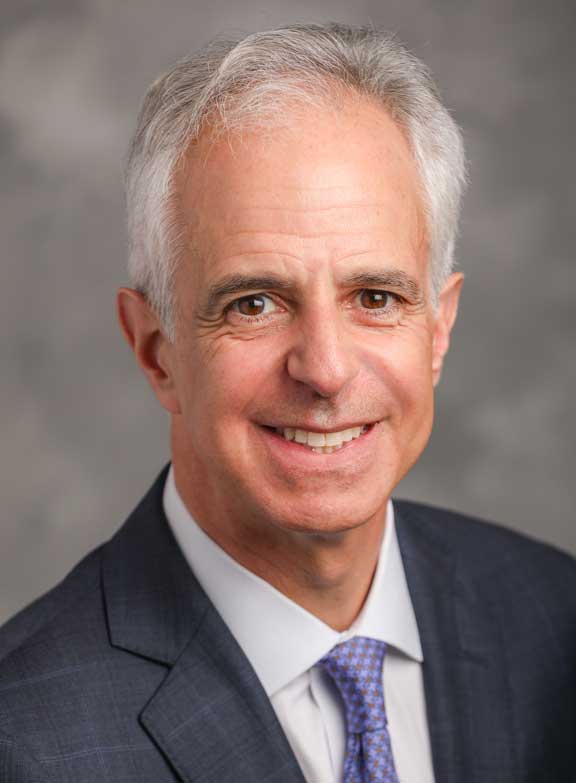This article was originally published in a sponsored newsletter.
In this month's Retina Minute, I have the pleasure of interviewing my friend, Dr. Carl Regillo. Dr. Regillo is professor of ophthalmology at the Wills Eye Hospital in Philadelphia, Pennsylvania.
Dr. Regillo, recently at Angiogenesis, Exudation, and Degeneration 2024, in Miami, Florida, you presented data from the DAVIO 2 study. Can you explain the study and what it potentially showed?
Sure, I am happy to discuss the DAVIO 2 data. This was a 2-part presentation on the DAVIO 2, which was a phase 2 randomized, prospective clinical trial that compared a single injection of EYP-1901 (EyePoint Pharmaceuticals) at 2 doses vs aflibercept (Eylea; Regeneron). The first presentation was by Dr. Charlie Wykoff who presented top-line efficacy and safety results, and the second part was by me with a deeper dive into initial subgroup analysis outcomes.
EYP-1901 is a tyrosine kinase inhibitor (TKI) called vorolanib packaged in a sustained-release bioerodible polyvinyl alcohol polymer that is injected intravitreally. For the clinical trial, we enrolled patients with neovascular AMD who were previously treated with a minimum of 2 anti-VEGF injections in the prior 6 months. They also had a broad visual acuity range and a central subfield thickness (CST) of less than 350 μm, selecting for well-controlled but frequently treated patients. Patients were randomized into 1 of 3 arms: single low (2 mg) dose EYP-1901, high (3 mg) dose EYP-1901, or aflibercept as the control arm dosed on-label every 8 weeks. All 3 arms had 3 monthly aflibercept doses for a loading phase at time 0, 4 weeks, and 8 weeks. In the 2 EYP-1901 arms, patients received the EYP injection at the third and final visit of the loading phase (week 8). After that, there could be supplemental aflibercept injections in all arms based on protocol criteria with monthly follow-ups. The trial’s primary endpoint was the mean change in BCVA from baseline to weeks 28 to 32 (averaged), which represents 6 months after the only EYP-1901 injection.
Patients’ baseline characteristics were well-balanced among the 3 arms, as expected. Patients had relatively good mean BCVA at ETDRS letters of 73-75 (Snellen equivalent of ~20/32), and had mean CST that was normal on average. The mean number of injections in the previous 12 months was high, averaging approximately 10 in each arm.
The study met its primary endpoint with both EYP-1901 doses showing noninferior mean change in BCVA from baseline out to weeks 28/32, along with good anatomic outcomes with OCT CST in the same range for all 3 arms. That was achieved with approximately 64% of patients in the EYP-1901 arms not receiving any supplemental injections out to week 32. Two-thirds of patients did not receive any additional treatments for 6 months. Further analysis showed that approximately 83% of patients in the EYP arms had either no or only one supplemental injection between weeks 8 and 32 (the 6-month timeframe to the primary endpoint).
For efficacy we saw excellent disease control in the maintenance phase for patients who had been previously treated for neovascular AMD with few or no supplemental injections. The safety profile also turned out to be good with no serious adverse events attributable to the EYP-1901.
In 1 subgroup analysis, we looked at whether supplemental injections influenced both vision and anatomic outcomes. We compared all eyes in the EYP-1901 arms vs eyes without supplemental injections, and the results were the same with both BCVA and OCT for the course of the study. We can conclude that regardless of whether patients had a supplemental injection, it did not appear to influence the results.
We also looked at a variety of baseline features, including BCVA (better or worse than 20/32), the duration of neovascular AMD (less than or greater than 12 months), and the historical number of anti-VEGFs in the prior 12 months (less than or equal to 5, or more than 6). In all these subgroups, no clinically meaningful differences were seen in either visual acuity or anatomic outcomes. From these analyses, we can say that we have a product that worked as expected in a broad range of neovascular AMD presentations.
To summarize DAVIO 2, EYP-1901 lived up to expectations in providing good disease control with noninferior visual acuity outcomes compared to bimonthly aflibercept in a broad neovascular AMD patient population with an 85% mean reduction of treatment burden. Two-thirds of patients were able to be injection-free for a 6-month timeframe. The treatment is also showing a good safety profile to date.
We also presented the next steps. Based on the success of DAVIO 2, we now have a draft of phase 3 protocols. The phase 3 program will likely start by the year's end; the 2 global trials will be similar to DAVIO 2 in the types of previously treated neovascular AMD patients enrolled. Also, like DAVIO 2, it will be a 3-arm study with 2 arms getting EYP-1901 and 1 arm getting aflibercept on-label, and all arms starting with 3 monthly loading doses of aflibercept. As a pivotal registration study, it will be a much larger and longer study conducted for 2 years with a 1-year primary visual endpoint. EYP-1901 will be reinjected at 6-month intervals for the course of the study.
As you know, TKIs are currently being looked at in clinical trials, and we are trying to compare different TKIs in terms of study design. What were the rescue criteria for DAVIO 2?
Similar to other neovascular AMD trials, DAVIO 2 had specific aflibercept rescue or supplemental treatment criteria at any of the monthly visits after the loading phase. There were both anatomic and visual criteria and also the presence of any new or worsening hemorrhage to trigger a supplement. The specific criteria were as follows: an increase in OCT CST of 100 μm from the lowest on-study, worsening of BCVA by 5 or more letters from best on-study and OCT CST of greater than 75 μm from lowest on-study, or worsening of BCVA of 10 or more letters from the best on-study measurement.
Recent phase 3 clinical trials have had more arms and more adaptability based on FDA guidance. How is this change reflected in the proposed phase 3 clinical trial for DAVIO?
The proposed phase 3 clinical trial is based on a type-C meeting with the FDA in the fourth quarter of 2022 and is believed to be consistent with the subsequent neovascular AMD draft guidelines for noninferiority clinical trials. Two doses of EYP-1901 tested in the phase 3 trials effectively allow for at least 1 comparator arm dosed in the same way which meets the criteria in the guidelines for comparators in such studies.
That is great to hear. Let's look 5 years down the road: how do you see treating patients with wet AMD with all the clinical trials and compounds that are being looked at?
The phase 2 and phase 3 study designs were for neovascular AMD patients who are being treated with anti-VEGF agents frequently. These are the exact type of patients for whom I would consider any sustained-release therapy. I am optimistic that the phase 3 trial results will also show good control of disease with reduced treatment burden in this high-need patient population. With that, I foresee offering EYP-1901 to my “frequent flier” patients, those whom I treat every 4, 5, or 6 weeks for whom I hope to minimize the injection treatment burden. I am also hopeful that this strategy will lead to better long-term vision outcomes for these patients.
Thank you so much for taking time to discuss this new class of medications. I believe that they have great potential, and they will be another tool that may give us the visual acuity we have come to expect while decreasing treatment burden.
I agree that this type of approach to managing neovascular AMD in the maintenance phase holds great promise for getting better visual outcomes for our patients. I am looking forward to these types of products being available for us to use in practice.










